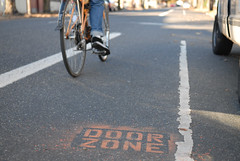If you ever have the unfortunate luck of coming into conflict with another road user, it’s always a pleasure to find out the law is in your favor.
Usually, conflicts on the road relate to the question of who has the right to the same space at the same time. Having someone open their car door into you — a.k.a. getting “doored” — falls into this category. Usually a motor vehicle operator fails to see a bicycle rider and opens a door so close to their path that a collision or near-miss occurs. While defensive riding can go a long way toward avoiding this sometimes painful encounter, sometimes there is just nothing a rider can do — everything happens too fast.
Fortunately, this is one of those areas where the law is on the side of the bicycle rider. Here’s the relevant section of Oregon’s Vehicle Code (remember bicycles are “vehicles” too) that prohibits opening the door of any vehicle unless it is reasonably safe to do so:
ORS 811.490: Improper opening or leaving open of vehicle door; penalty. (1) A person commits the offense of improper opening or leaving open a vehicle door if the person does any of the following:
(a) Opens any door of a vehicle unless and until it is reasonably safe to do so and it can be done without interference with the movement of traffic, or with pedestrians and bicycles on sidewalks or shoulders.
(b) Leaves a door open on the side of a vehicle available to traffic, or to pedestrians or bicycles on sidewalks or shoulders for a period of time longer than necessary to load or unload passengers.
(2) The offense described in this section, improper opening or leaving open a vehicle door, is a Class D traffic infraction.
The scheduled bail amount for a Class D Traffic Infraction is $110.00, and the fine is the same. Note that the law makes it illegal not only to open the door when it interferes with people trying to get by, but it is also illegal to leave the door open longer than necessary to load or unload passengers.
One would think that the law is so clear-cut that disputes over who was at fault would never arise. Unfortunately that’s not the case.
From my experience investigating these cases, the motor vehicle driver is apologetic and completely willing to accept blame at the scene (in spite of the advice on many insurance identification cards which state, “do not accept fault for the accident”). But, by the time the motor vehicle operator thinks about it and talks to an insurance adjuster or attorney, their view of what happened suddenly changes.
The revised version goes something like this:
“I opened my car door with plenty of distance behind me for the approaching bicyclist to see it. If the bicyclist had been paying attention, he or she would have seen that my door was open and ridden around it. Since I only intended to have the door open long enough to get out of the car, the accident is mostly the fault of the bicyclist.”
Believe it or not, this argument is enough to inject a note of comparative negligence on the part of the person operating a bicycle into the equation in most cases.
The percentage of comparative fault works out to a pro rata reduction in the amount of damages, so the effect is significant. Add the fact that most of the members of any jury will identify primarily with the motor vehicle operator, not the bicycle rider, and you have a recipe for disappointment. Remember, under Oregon’s system of comparative fault, if a jury decides that the motor vehicle operator was partly at fault for opening the car door (less than 50%) but the person riding a bicycle was mostly at fault (more than 50%) for failing to pay close enough attention and to make a reasonable effort to avoid striking the open door, then the person riding the bicycle loses in court — even though the person operating the motor vehicle violated the vehicle code by his or her own admission.
I’ve found that in almost every car door collision case the person operating the motor vehicle is primarily at fault. However, it is essential in every case that the person riding the bicycle carefully remember and reconstruct the scene of the incident to demonstrate that there was not enough time to take necessary evasive action in order to avoid hitting the door. Usually, bicycle riders relate that things just happened too fast and there was simply not enough time to avoid the car door.
While it’s nice to have the law on your side, you also need to be prepared to make your case to an insurance adjuster. Knowing, and being ready to present in advance, Oregon’s law and a mental reconstruction of how the collision happened will prepare you to make a successful insurance claim.

(Photo © J. Maus/BikePortland)
This article is part of our monthly legal series with Portland-based lawyer and bike law expert Ray Thomas of Swanson, Thomas, Coon & Newton. (Disclaimer: STC&N is a BikePortland advertiser and this article is part of a paid promotional partnership.)


